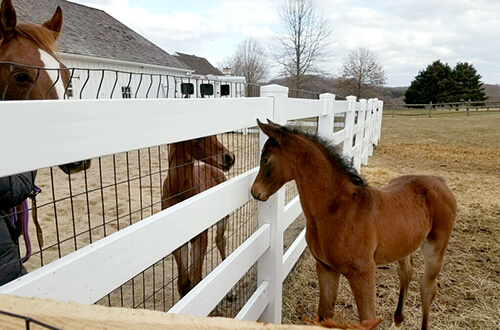Last February, Lisa Gaudio and her husband Jim Kazanjian had to say goodbye to their beloved half-Arabian, Kyrie Eleison. The dark bay mare had fought a long battle with laminitis, spending many weeks at Penn Vet’s New Bolton Center under the care of a dedicated team that included Dr. James Orsini, Associate Professor of Surgery, and Patrick Reilly, Chief of Farrier Services.
“Kyrie was a true fighter,” Gaudio said. “But she made it clear to us that she was finally ready to say goodbye.”
Kyrie was discharged from the hospital and taken home, where she could spend her final days in the comfort of her stall. Surrounded by Gaudio, Kazanjian, and her veterinary team, she was euthanized. Despite the loss, Gaudio’s sadness soon turned to optimism, thanks to a post-mortem procedure that would allow Kyrie’s legacy to continue.
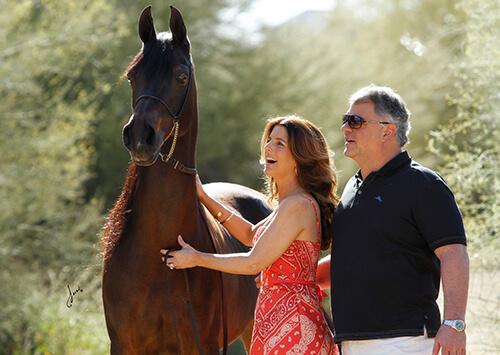 Hope after Death
Hope after Death
“Since Kyrie was such a special horse, I had asked about the best way to carry on her line,” said Gaudio. Prior to Kyrie’s death, Dr. Tamara Dobbie, Associate Professor of Large Animal Reproduction, explored the options. She shared with Gaudio that there was a procedure that would not cause additional discomfort to Kyrie in her final days.
“In speaking with our colleagues at Texas A&M, we found that there was really no difference in embryo development rates if the ovaries were extracted before or after death,” explained Dobbie.
Gaudio was both surprised and delighted to learn about the option for post-mortem recovery of oocytes. “I kept thinking, ‘Can this really happen? Are we this lucky?’” she said.
Gaudio and Kazanjian agreed to the procedure, and selected bay stallion Vitorio TO, a five-time national champion Arabian, as the sire. But it would require a coordinated effort by a team of experts from across the country to make the procedure a success.
A Team Effort
Following Kyrie’s death, her primary care veterinarian, Dr. Jill Acland, removed the ovaries, which were then brought to Dobbie at New Bolton’s Hofmann Center for Animal Reproduction.
Dobbie and her team were able to recover 15 oocytes in a painstaking process that typically requires about two to three hours and two to three people. “First, we take the ovaries and remove all of the extra tissue. Then we meticulously cut each ovary, making sequential cuts every centimeter or so,” explained Dobbie. “When we slice into the ovary and open it up, we can see the follicles. We then scrape the inside of each follicle with a bone curette. With every scrape, we take a look at what we’ve recovered. It’s very time-consuming and tedious work.”
During the procedure, Dobbie and her team can get into tiny follicles, mere millimeters in size, to recover oocytes. “We’re able to get into follicles that we could never get into with a needle in a live mare,” she said. “Our recovery rate is around 80 percent.”
But with post-mortem recovery, time is of the essence. “We have to get the oocytes out as quickly as possible,” Dobbie said. “The longer they’re in there, the higher the chance that you’ll have degenerate oocytes. So we try to get the eggs out within six hours of death. That seems to be the critical time period.”
Day or night, Dobbie and her team are on call to receive ovaries and recover oocytes for clients. After the procedure, the oocytes are either put on a flight or shipped via FedEx to Texas A&M.
In Kyrie’s case, the oocytes were shipped overnight to the team in Texas. There, 10 of the oocytes matured in vitro. Vitorio TO’s owner, Janey Morse, and Team Midwest made sure to deliver the semen in time. The oocytes were then injected with a single sperm through an advanced reproductive technique called intracytoplasmic sperm injection, or ICSI. All 10 cleaved and four went on to actually develop into transferable embryos.
The experts at Texas A&M then shipped the embryos to Weatherford Equine Medical Center in Weatherford, TX, for transfer into surrogate mares. Remarkably, three of the four embryos resulted in pregnancies.
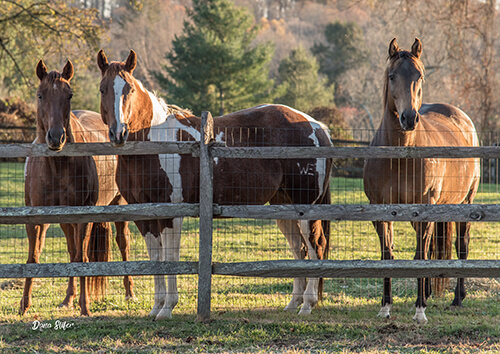
“To think that we had such success with so many people involved is pretty amazing,” said Dobbie. “There were a lot of moving parts and so many points where things could have gone wrong. It’s wonderful to have played a part in this huge undertaking.”
Gaudio was equally amazed. “I couldn’t believe it when I learned there were three!” she said. “It was an amazing team effort. And the timing had to be so precise. Everything was synchronized beautifully. To have so many people that I respect in the industry work together on this effort was really special.”
“Miracle Babies”
In the beginning of November 2016, the three surrogate mares traveled from their ranch in Texas to New Bolton Center. After five days at the Hofmann Center, they went to Gaudio’s farm until it was time to foal.
The mares, Mercy, Peace, and Grace, were named at Weatherford in honor of Kyrie, whose full name, Kyrie Eleison, means “Lord, have mercy” when translated from the Greek. With estimated due dates around January 17, 2017, the mares returned to New Bolton Center on December 28, 2016. Then, there was nothing to do but monitor them in the NICU and wait.
At 3:30 a.m. on January 16, Kyrie’s first foal was welcomed into the world, a sprightly filly born to Mercy. “Mercy went by the book,” said Dr. Michelle Linton, Internal Medicine and Neonatal Intensive Care Specialist. “She waxed the day before and dripped a few drops of milk that evening. The foaling couldn’t have gone smoother.”
Gaudio named the filly Epona Eleison, after Epona, the Greek protector of horses, ponies, donkeys, and mules. Epona is also the goddess of fertility, a particularly fitting tribute. Right away, Epona began to take after Kyrie.
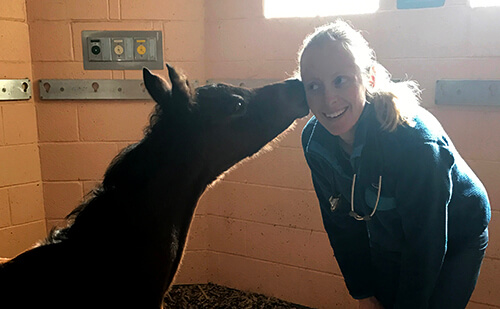
“In true Kyrie fashion, she was bucking and running around her stall at only two hours of age,” said Linton.
“I see so much of Kyrie in Epona,” added Gaudio. “She’s so inquisitive, always in your face.”
A few days later, on January 22, Peace foaled shortly after 3:00 a.m. “The mares were quite considerate in spacing things out for us,” said Linton.
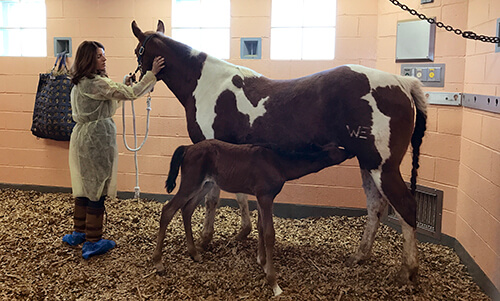
This time, the team helped to deliver a colt named Big Man in Town. According to Gaudio, he is already living up to his name. “He is rearing and giving his mom a hard time,” she said. “His personality is starting to mirror Epona’s, but she’s still the boss.”
Keeping everyone in suspense was Grace, who finally foaled on February 1 at 11:55 p.m.
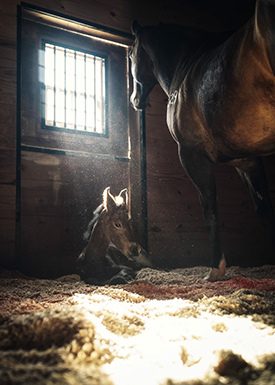 “True to her quiet nature, she tried to sneak it by us,” said Linton. “She pawed twice and suddenly there was a foal!” The filly, finer in build than her siblings, was up and nursing in only 45 minutes and has barely laid down since. “She has a little ‘V’ marking on her muzzle,” said Linton. “I’m sure Vitorio would approve!”
“True to her quiet nature, she tried to sneak it by us,” said Linton. “She pawed twice and suddenly there was a foal!” The filly, finer in build than her siblings, was up and nursing in only 45 minutes and has barely laid down since. “She has a little ‘V’ marking on her muzzle,” said Linton. “I’m sure Vitorio would approve!”
In another nod to Vitorio TO, Gaudio named the filly Elle Vitorina—an homage to both parents (Elle for Eleison and Vitorina for Vitorio).
“I couldn’t be happier,” said an emotional Gaudio. “I call them my miracle babies.”
A few days later, on February 4, Elle Vitorina was discharged. It was exactly one year from the date of Kyrie’s final discharge from New Bolton Center.
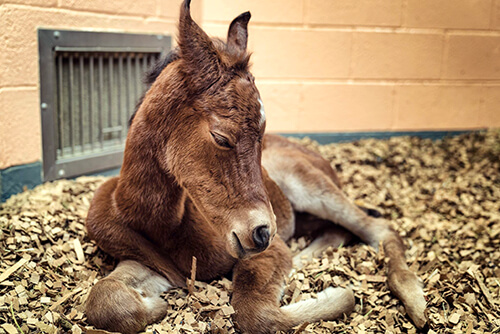
Life on the Farm
Epona, Big Man in Town, and Elle Vitorina each have exhibited qualities reminiscent of their mother. “Kyrie would play and communicate with you, but she also knew when it was time to do her job,” said Gaudio. “She was a wonderful show horse, but she could still be loved and hugged.”
The foals, registered half-Arabians, will also become show horses. “I’m not sure yet where they will go for training, but they’ll go on to do what Kyrie did,” said Gaudio. “She was a Canadian national champion, a U.S. national top ten mare, and she won some halter classes, so we have high hopes.”
In the meantime, the three foals and three mares are all enjoying life at Gaudio’s farm. She and Kazanjian have decided to keep the mares rather than send them back to Texas. “I couldn’t let them go. They played such a special role and they are so bonded to one another,” she said.
Through all of these horses, Kyrie’s legacy is alive and well. In fact, the foals represent four generations of breeding; Gaudio owned their great-grandmother, grandmother, and mother. It’s a meaningful connection that fills her with pride. “I am absolutely euphoric that Kyrie was able to give us these gifts,” Gaudio said. “And I’m so grateful to the amazing team that came together to make it all possible.”
